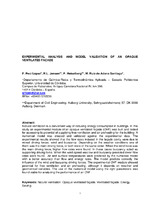Experimental analysis and model validation of an opaque ventilated facade

Autor
Peci López, Fernando
Jensen, R.L.
Heiselberg, P.
Ruiz de Adana, Manuel
Editor
ElsevierFecha
2012Materia
Energy savingNatural ventilation
Opaque ventilated façade
Ventilated façade
METS:
Mostrar el registro METSPREMIS:
Mostrar el registro PREMISMetadatos
Mostrar el registro completo del ítemResumen
Natural ventilation is a convenient way of reducing energy consumption in buildings. In this study an experimental module of an opaque ventilated façade (OVF) was built and tested for assessing its potential of supplying free ventilation and air preheating for the building. A numerical model was created and validated against the experimental data. The experimental results showed that the flow rates induced in the façade cavity were due to mixed driving forces: wind and buoyancy. Depending on the weather conditions one of them was the main driving force, or both were of the same order. When the wind force was the main driving force, higher flow rates were found. In these cases buoyancy acted as supporting driving force. When the wind speed was low and buoyancy prevailed lower flow rates were found. Air and surface temperatures were predicted by the numerical model with a better accuracy than flow and energy rates. The model predicts correctly the influence of the wind and buoyancy driving forces. The experimental OVF module showed potential for free ventilation and air preheating, although it depends on weather and geometrical variables. The use of the numerical model using the right parameters was found viable for analyzing the performance of an OVF.
